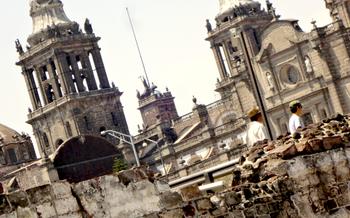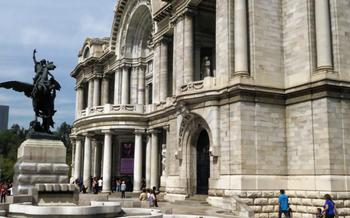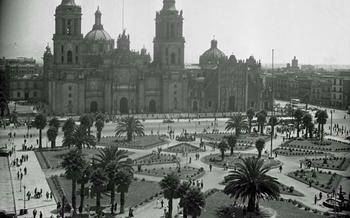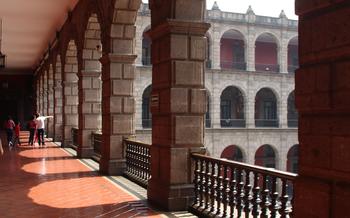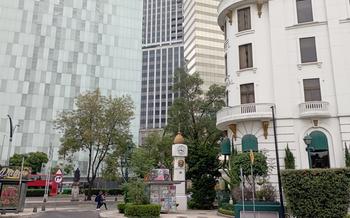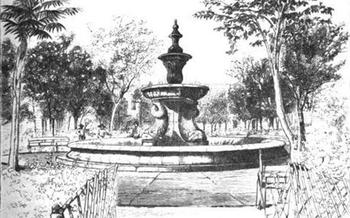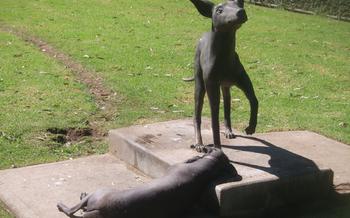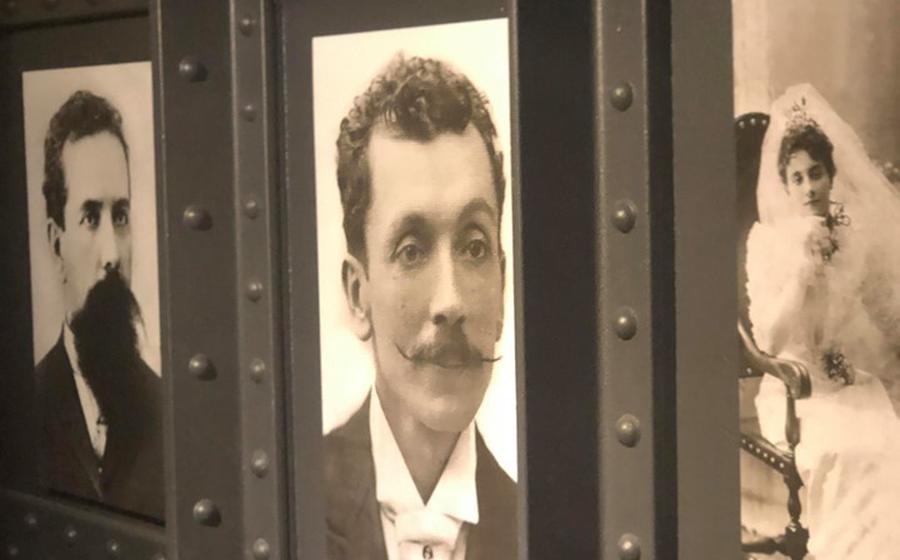
Museo Nacional de la Revolución
- Unveiling the History of Mexico's Revolutionaries
- The Building's Architectural Masterpiece
- Navigating the Museum's Exhibitions
- Immerse Yourself in Revolutionary Art
- Discover the Museum's Unique Collections
- Interactive Learning for All Ages
- Explore the Museum's Surroundings
- Embrace the Vibrant Cultural Scene
- Plan Your Visit for a Memorable Experience
- Engage with the Museum's Online Presence
- Insider Tip: Hidden Gems of the Museum
Unveiling the History of Mexico's Revolutionaries
The Museo Nacional de la Revolución stands as a testament to the pivotal events and figures that shaped Mexico's revolutionary movement. The museum's collection encompasses a wealth of artifacts, documents, and interactive displays that shed light on the historical context, struggles, and triumphs of this transformative period.
Historical Context: Mexico's revolutionary movement emerged in the early 20th century as a response to political oppression, economic inequality, and social injustice. The rule of President Porfirio Díaz, marked by authoritarianism and cronyism, fueled widespread discontent among various sectors of society, including peasants, workers, and intellectuals.
Revolutionary Figures: The museum pays homage to prominent figures who played a crucial role in the revolution. Emiliano Zapata, a peasant leader from the southern state of Morelos, fought for land rights and social justice for the marginalized indigenous communities. Francisco I. Madero, a wealthy landowner from Coahuila, emerged as a key figure in the anti-reelectionist movement that sought to end Díaz's rule.
Struggles and Victories: The Mexican Revolution was a complex and protracted struggle that unfolded over several years. The museum chronicles the challenges faced by revolutionary forces as they battled against the federal army and conservative factions. Visitors can learn about the battles, alliances, and strategies that ultimately led to the overthrow of Díaz's regime in 19
Impact on Modern Mexico: The Mexican Revolution left a profound impact on the nation's identity and political landscape. The museum highlights the revolution's legacy in terms of social reforms, land distribution, and the establishment of a new constitutional order. The revolution's ideals and principles continue to shape modern-day Mexico, making it a crucial chapter in the country's history.
The Building's Architectural Masterpiece
The Museo Nacional de la Revolución stands as a testament to architectural ingenuity, having undergone a remarkable transformation from a luxurious mansion to a museum dedicated to preserving Mexico's revolutionary history. The building's eclectic architectural style blends neoclassical, art nouveau, and Mexican colonial elements, creating a unique and visually captivating structure.
Originally constructed in the late 19th century as the residence of Porfirio Díaz, the mansion's opulent design reflected the wealth and power of Mexico's former dictator. However, following the Mexican Revolution, the building was repurposed to serve as a museum dedicated to showcasing the nation's revolutionary struggle.
The museum's architects skillfully incorporated revolutionary symbolism into the building's design, paying homage to the heroes and events that shaped Mexico's history. The facade is adorned with intricate reliefs depicting scenes from the revolution, while the interior features stained glass windows and murals that narrate the stories of Mexico's revolutionary leaders.
In recent years, the museum has undergone extensive renovation and preservation efforts to restore its original grandeur and maintain its historical integrity. These efforts have ensured that the Museo Nacional de la Revolución continues to stand as a symbol of Mexico's revolutionary spirit and a testament to the nation's rich architectural heritage.
Navigating the Museum's Exhibitions
The Museo Nacional de la Revolución boasts a diverse collection of permanent and temporary exhibitions, offering visitors a comprehensive journey through Mexico's revolutionary history. Permanent exhibits take center stage, showcasing artifacts, documents, and multimedia displays that narrate the key events, struggles, and triumphs of the revolutionary era. These exhibits provide a solid foundation for understanding the complexities of the Mexican Revolution.
Temporary exhibitions offer a fresh perspective, delving into specific aspects of the revolution or featuring the works of renowned artists and historians. These rotating displays keep the museum's offerings dynamic and engaging, ensuring that there's always something new to discover.
Interactive experiences are seamlessly integrated throughout the museum, inviting visitors to engage with the content in a hands-on manner. Multimedia displays bring history to life, allowing visitors to immerse themselves in the sights and sounds of the revolutionary era. Interactive activities invite visitors to test their knowledge and explore different perspectives, making the learning process enjoyable and interactive.
Guided tours are available for those who prefer a more structured experience. Knowledgeable guides lead visitors through the museum's highlights, providing in-depth insights and answering questions. Tours are offered in various languages, catering to a diverse audience. Reservations are recommended to secure a spot on a guided tour.
Immerse Yourself in Revolutionary Art
The Museo Nacional de la Revolución is not just a repository of historical artifacts; it is also a treasure trove of revolutionary art. The museum houses a significant collection of murals, paintings, and sculptures that vividly depict the struggles, triumphs, and ideals of the Mexican Revolution. These artworks not only serve as historical documents but also as powerful expressions of artistic creativity and social commentary.
One of the highlights of the museum's art collection is the series of murals by renowned Mexican artist Diego Rivera. Rivera's murals, which adorn the walls of the museum's main staircase, depict key moments in the revolution, such as the Battle of Puebla and the signing of the Constitution of 191These murals are not only visually stunning but also deeply symbolic, conveying Rivera's own political and social views.
Another notable artist featured in the museum is José Clemente Orozco. Orozco's murals, which can be found in the museum's basement, are known for their dramatic and emotional intensity. They depict scenes of violence, suffering, and social injustice, offering a powerful indictment of the human cost of war and revolution.
In addition to these two giants of Mexican art, the museum also features works by other talented artists, such as David Alfaro Siqueiros, Roberto Montenegro, and Fernando Leal. Together, these artists created a body of work that not only documented the Mexican Revolution but also helped to shape its legacy and inspire future generations of artists and activists.
Beyond the murals, the museum also houses a collection of paintings, sculptures, and graphic works that explore the themes of the revolution from various perspectives. These works offer a glimpse into the lives and experiences of ordinary people who lived through this tumultuous period in Mexican history.
Whether you are an art enthusiast, a history buff, or simply someone who appreciates powerful storytelling, the Museo Nacional de la Revolución's art collection is not to be missed. These artworks offer a unique and unforgettable window into the Mexican Revolution, allowing visitors to experience the passion, the drama, and the transformative power of art.
Discover the Museum's Unique Collections
The Museo Nacional de la Revolución boasts a treasure trove of unique collections that provide a tangible connection to the events and personalities that shaped Mexico's revolutionary history. These collections, housed within the museum's hallowed halls, offer visitors a glimpse into the lives and struggles of the men and women who fought for a new era in Mexico.
Photographs and Documents
One of the most significant collections comprises historical photographs and documents that capture the faces, places, and events of the revolution. These precious images, frozen in time, offer a poignant glimpse into the lives of revolutionary leaders, soldiers, and ordinary citizens caught in the throes of a nation's transformation. The documents, ranging from manifestos to personal letters, provide a written record of the ideals, strategies, and challenges faced by the revolutionaries.
Personal Belongings
The museum also houses a collection of personal belongings that once belonged to the men and women who led the fight for change. From the ornate hat of Emiliano Zapata to the humble clothing worn by Francisco I. Madero, these artifacts offer a personal connection to the individuals who shaped Mexico's destiny. Visitors can marvel at the intricately embroidered shawls worn by soldaderas, the female fighters who played a crucial role in the revolution, and the weathered uniforms of generals who led their troops into battle.
Weapons and Military Equipment
The Museo Nacional de la Revolución showcases an impressive array of weapons and military equipment used during the revolution. From the iconic rifles carried by rebel soldiers to the heavy artillery that thundered across the battlefields, these artifacts provide a tangible reminder of the violence and destruction that ravaged Mexico during this tumultuous period. Visitors can examine the intricate mechanisms of firearms, the gleaming bayonets that once pierced enemy lines, and the shells that roared from cannons, gaining a deeper understanding of the tools that shaped the course of the revolution.
Interactive Displays
The museum's commitment to preserving and presenting history in an engaging and interactive manner is evident in its use of multimedia displays. These cutting-edge exhibits bring the past to life, allowing visitors to immerse themselves in the sounds, sights, and emotions of the revolution. Through interactive touchscreens, visitors can explore maps, timelines, and biographies of key figures, gaining a deeper understanding of the complex events that unfolded during this transformative period.
Interactive Learning for All Ages
The Museo Nacional de la Revolución offers a range of interactive and engaging experiences that cater to visitors of all ages. Educational programs, workshops, and lectures provide students with a deeper understanding of Mexico's revolutionary history. Families can enjoy interactive exhibits and programs designed to spark curiosity and ignite a passion for learning. Accessibility features ensure that visitors with disabilities have an inclusive and enjoyable experience. Multi-lingual resources, including translations and audio guides, make the museum accessible to international visitors. Through these initiatives, the museum fosters a welcoming and inclusive environment that encourages lifelong learning and appreciation for Mexico's revolutionary heritage.
Explore the Museum's Surroundings
The Museo Nacional de la Revolución is strategically located within Mexico City's historic center, a vibrant neighborhood teeming with cultural landmarks and attractions. The museum's proximity to other notable sites allows visitors to seamlessly immerse themselves in the city's rich history and heritage.
Historic District: The museum is nestled within the heart of Mexico City's Centro Histórico, a UNESCO World Heritage Site renowned for its well-preserved colonial architecture, cobblestone streets, and grand plazas. Visitors can explore iconic landmarks such as the Templo Mayor, the Metropolitan Cathedral, and the Palacio Nacional, all within walking distance of the museum.
Nearby Attractions: After delving into the history of the Mexican Revolution, visitors can venture further into the historic center to discover a myriad of nearby attractions. The Museo del Templo Mayor offers an intriguing glimpse into the ancient Aztec civilization, while the Museo Nacional de Antropología showcases an impressive collection of pre-Hispanic artifacts. For art enthusiasts, the Palacio de Bellas Artes is a must-visit, housing renowned murals by Diego Rivera and other Mexican masters.
Transportation Options: Getting to and from the Museo Nacional de la Revolución is a breeze, with convenient public transportation options available. The Metrobus system, with its dedicated lanes, offers a quick and efficient way to reach the museum. Alternatively, visitors can opt for the Turibus, a hop-on, hop-off sightseeing bus that stops at major landmarks, including the museum.
Safety Tips: While Mexico City is generally safe for tourists, it's always advisable to exercise caution, especially when exploring unfamiliar areas. Be aware of your surroundings, avoid walking alone at night, and keep valuables secure. The museum's location within the well-lit and heavily trafficked historic center contributes to its overall safety.
Embrace the Vibrant Cultural Scene
The Museo Nacional de la Revolución is not just a repository of historical artifacts; it is also a vibrant cultural hub that hosts a range of events and exhibitions that celebrate Mexican culture and history. Throughout the year, the museum organizes festivals, concerts, and cultural performances that showcase the diverse artistic expressions of Mexico. These events provide visitors with an opportunity to immerse themselves in the country's rich cultural heritage and gain a deeper understanding of its revolutionary spirit.
The museum also hosts temporary exhibitions that showcase contemporary art and cultural expressions, providing a platform for emerging artists and promoting dialogue on current social and political issues. Through these exhibitions, the museum aims to foster a vibrant cultural exchange and encourage critical thinking about the past, present, and future of Mexico.
In addition to its own programming, the museum collaborates with other cultural institutions and organizations to present joint exhibitions and events. These collaborations bring together diverse perspectives and expertise, enriching the museum's offerings and creating a dynamic cultural space that is constantly evolving.
The Museo Nacional de la Revolución's commitment to cultural engagement extends beyond its physical walls. The museum actively participates in community outreach programs, working with local schools and organizations to promote cultural education and foster a sense of pride in Mexico's revolutionary history. Through these initiatives, the museum plays a vital role in preserving and celebrating the nation's cultural heritage while also fostering dialogue and understanding among its diverse communities.
Plan Your Visit for a Memorable Experience
To ensure a seamless and enriching visit to the Museo Nacional de la Revolución, plan ahead with these essential details. The museum welcomes visitors from Tuesday to Sunday, with doors opening at 10 am and closing at 5 pm. Plan to allocate at least two hours to immerse yourself in the exhibits and soak in the historical significance of the museum.
Admission fees are structured to make the museum accessible to all. General admission tickets are priced reasonably, with discounts offered to students, seniors, and groups. To elevate your experience and gain deeper insights into the museum's treasures, consider booking a guided tour. These tours are conducted by knowledgeable guides who bring the exhibits to life through engaging narratives.
The museum offers a range of amenities to ensure a comfortable and enjoyable visit. Restrooms are conveniently located throughout the building, allowing you to refresh as needed. If you find yourself in need of sustenance, the museum's cafe provides a welcoming space to grab a bite to eat or sip on a refreshing beverage. And don't forget to visit the gift shop, where you can purchase souvenirs and mementos to commemorate your visit.
Engage with the Museum's Online Presence
Embrace the convenience of exploring the Museo Nacional de la Revolución beyond its physical walls. Dive into virtual tours that allow you to navigate the museum's exhibits and collections from the comfort of your own home. Immerse yourself in the captivating stories and artifacts through interactive online exhibitions.
Stay connected with the museum's vibrant community by following their social media platforms. Engage in thought-provoking discussions, share your experiences, and stay updated on upcoming events, exhibitions, and educational programs.
Participate in webinars, lectures, and virtual events hosted by the museum. These online gatherings offer unique opportunities to interact with experts, delve deeper into specific topics, and broaden your understanding of Mexico's revolutionary history.
Unlock a wealth of information by accessing the museum's digital archives. Explore digitized historical documents, photographs, and research materials that provide invaluable insights into the Mexican Revolution. These online resources offer a treasure trove of knowledge for researchers, historians, and anyone passionate about this transformative period in Mexican history.
Insider Tip: Hidden Gems of the Museum
Beyond the main galleries and exhibits, the Museo Nacional de la Revolución holds hidden treasures waiting to be discovered. One secret spot is the rooftop terrace, offering a panoramic view of Mexico City's historic center. Here, visitors can soak in the beauty of the city while contemplating the museum's place within its historical fabric.
Another hidden gem is the "Sala de la Revolución Mexicana," a room dedicated to the everyday lives of ordinary Mexicans during the revolutionary era. This exhibit showcases personal belongings, photographs, and letters that provide a glimpse into the challenges and experiences of ordinary people caught in the turmoil of war.
For those seeking a deeper understanding of the museum's collection, guided tours led by knowledgeable docents are available. These tours offer exclusive access to off-the-beaten-path exhibits and provide insights into the symbolic elements and overlooked artifacts that often go unnoticed by casual visitors.
By venturing beyond the main attractions, visitors can uncover the hidden gems of the Museo Nacional de la Revolución, gaining a richer appreciation for the complexity and significance of Mexico's revolutionary history.
